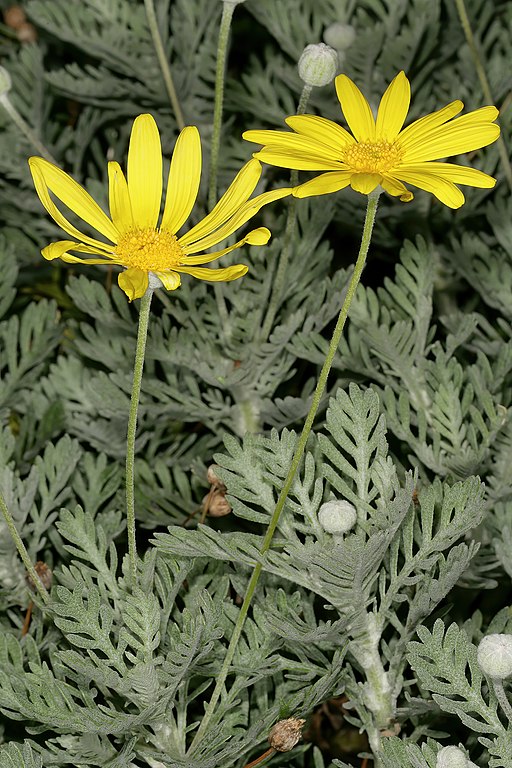Classification System: APG IV
Superregnum: Eukaryota
Regnum: Plantae
Cladus: Angiosperms
Cladus: Eudicots
Cladus: Core eudicots
Cladus: Asterids
Cladus: Campanulids
Ordo: Asterales
Familia: Asteraceae
Subfamilia: Asteroideae
Tribus: Senecioneae
Subtribus: Othonninae
Genus: Euryops
Species: Euryops pectinatus
Subspecies: E. p. subsp. lobulatus – E. p. subsp. pectinatus
Name
Euryops pectinatus (L.) Cass., Dict. sci. nat. 16:51. 1820
References
Cass., Dictionnaire des Sciences Naturelles, ed. 2, 16: 51. 1820.
Links
Hassler, M. 2018. Euryops pectinatus. World Plants: Synonymic Checklists of the Vascular Plants of the World In: Roskovh, Y., Abucay, L., Orrell, T., Nicolson, D., Bailly, N., Kirk, P., Bourgoin, T., DeWalt, R.E., Decock, W., De Wever, A., Nieukerken, E. van, Zarucchi, J. & Penev, L., eds. 2018. Species 2000 & ITIS Catalogue of Life. Published online. Accessed: 2018 Feb. 26. Reference page.
International Plant Names Index. 2018. Euryops pectinatus. Published online. Accessed: Feb. 26 2018.
The Plant List 2013. Euryops pectinatus in The Plant List Version 1.1. Published online. Accessed: 2018 Feb. 26.
Tropicos.org 2018. Euryops pectinatus. Missouri Botanical Garden. Published online. Accessed: 26 Feb. 2018.
USDA, ARS, Germplasm Resources Information Network. Euryops pectinatus in the Germplasm Resources Information Network (GRIN), U.S. Department of Agriculture Agricultural Research Service. Accessed: 07-Oct-06.
Vernacular names
Afrikaans: Gouemagrietjie
Deutsch: Gelbe Strauchmargerite
English: Grey-leaved Euryops
español: Margarita amarilla
français: Euryops pectiné
Euryops pectinatus, the grey-leaved euryops, is a species of flowering plant in the family Asteraceae, endemic to rocky, sandstone slopes in the Western Cape of South Africa (from Gifberg to the Cape Peninsula).[1]
Description
Mature shrub
It is a vigorous evergreen shrub growing to 1.5 m (4 ft 11 in) tall and wide, with silvery green, hairy leaves and yellow, daisy-like composite flowers 5 cm (2 in) in diameter.[2] They bloom from early summer through to autumn and into winter in areas with mild climates.
The fruits bear a single seed and are either hairless or covered in myxogenic (slime-producing) hairs, and may also be topped by a pappus of white or brown bristles.[2]
The Latin specific epithet pectinatus means “comb-like”,[3] possibly referring to the deeply-divided, fernlike leaves.
Cultivation
Euryops pectinatus is widely used as a garden plant, especially in urban areas and due to its almost perpetual flowering regime. It grows best in full sun and well-drained deep soils. It must be grown in a sheltered location, away from frost-prone areas. It has gained the Royal Horticultural Society's Award of Garden Merit.[4][5]
All parts of the plant are poisonous if ingested.[2]
References
"Euryops pectinatus". SANBI, PlantZAfrica.com. Retrieved 26 February 2018.
"Euryops pectinatus Cass. | Plants of the World Online | Kew Science". Plants of the World Online. Retrieved 2019-03-25.
Harrison, Lorraine (2012). RHS Latin for Gardeners. United Kingdom: Mitchell Beazley. ISBN 184533731X.
"RHS Plant Selector - Euryops pectinatus". Retrieved 19 June 2020.
"AGM Plants - Ornamental" (PDF). Royal Horticultural Society. July 2017. p. 38. Retrieved 26 February 2018.
Retrieved from "http://en.wikipedia.org/"
All text is available under the terms of the GNU Free Documentation License


